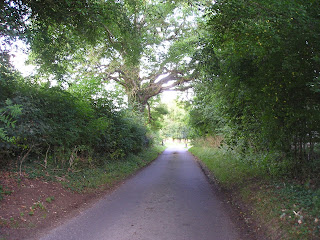The Long Distance Painted Ladies
 And it's offical: it started in Spring when the BBC reported (so it must be true!) that clouds of Painted Ladies had been seen off the English coast, soon to arrive from annual migration from Africa. And sure enough, just a few days later, the hedgerows of the secret valley suddenly had dozens of them resting on the fresh new leaves and, every so often, stretching their wings to absorb what warmth there was.
And it's offical: it started in Spring when the BBC reported (so it must be true!) that clouds of Painted Ladies had been seen off the English coast, soon to arrive from annual migration from Africa. And sure enough, just a few days later, the hedgerows of the secret valley suddenly had dozens of them resting on the fresh new leaves and, every so often, stretching their wings to absorb what warmth there was.
Then just as suddenly they were gone! They had laid their eggs and, I assume died, their purpose in life over. Now they are back, or if I'm correct, their offspring are, feeding on the late summer nectar of the wild flowers and, in the garden, on the lavender and buddleia bushes.
The Peacocks, too, are plentiful but these we see all year round, for in the winter they come into the cottage and hibernate in between the folds of the curtains or some other dark place. Periodically, when the log burner is set on high and the house warms up, they fly around before settling down again for another long sleep. The one below is feeding in the garden on Phlox 'Hesperis', so called because of its similarity to the Dame's Violet - and just as beautifully fragrant.
It is the smaller butterflies that I especially like, the subdued markings of the Speckled Wood have the loveliest 'eye spots' on their wings, the colour of Devonshire clotted cream. The Gatekeeper is a much livelier and brighter coloured one, the one in the photo conveniently stopped for a moment on a wild scabious.


The 'blues' are the trickiest to identify. The two photographs below are of the Small Blue (I think), the female not looking very blue at all!


And soon all will be gone! Some migrating back to Africa or hibernating in a log pile or other sheltered place but the majority dying with the frosts,their species overwintering as pupa below the leaf litter to emerge as adults in the spring - which is, perhaps, the biggest test of 'as tough as old boots' of them all.

Just beautiful and lovely descriptions! Our claim to fame here are Monarchs :) Nothing quite so spectacular as you have.
ReplyDeleteIt is amazing isn't it, they look so frail, yet not just the English summer they cope with but migrating further than most of us would go on holiday.
ReplyDeleteWe used to live in Swanage, Dorset, and one Spring morning in the early hours I was walking the coast path at Durlston and met a scientist who was counting moth species as they crossed the coast. I never knew before then that they migrated, I'd always presumed that was mainly something for the birds.
Thanks Jeannie, glad you enjoyed the blog. According to my book, Monarchs very occasionally arrive in England from America - extraordinary! I assume it must be more by accident than design. Johnson
ReplyDeleteHow interesting, Heskie, that you came across someone looking out for moths. We sometimes get Humming Bird Hawkmoths feeding on our Red Valerian plants in the summer - they are the only migratory moth I know of (also from Africa, I think) - until now! There is always so much to learn...
ReplyDeleteWelcome to the secret valley, I hope you will return regularly. Johnson
What a pretty variety of butterflies you see there, and such nice pictures. We haven't seen very many this summer even though I've been planting lots of butterfly attracting plants.
ReplyDeleteYes, Catherine, we are lucky here with the variety we see. I think that this year has been good for them because it was hot and dry when they were breeding and they seem to have coped ok with the cool wet weather since then. Johnson
ReplyDeleteWe were over in the Turkdean area the other day and saw lots of blues - they don't come over to our part of the Cotswolds, so it was lovely to see them, and also the Adonis, which is bluer than blue! It's been a great year for butterflies, let's hope it's not just a blip and there will be more next year.
ReplyDeleteI don't think I've ever seen an Adonis - well not a butterfly, anyway! How lucky!
ReplyDelete